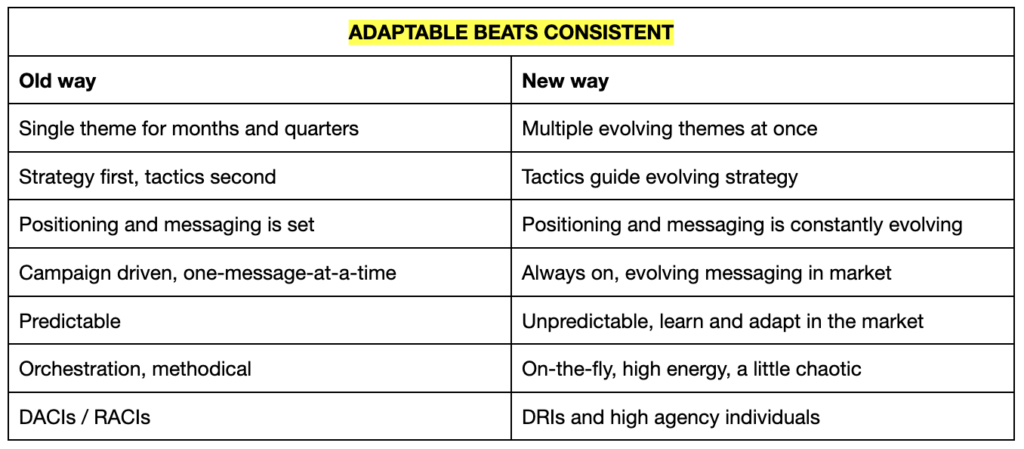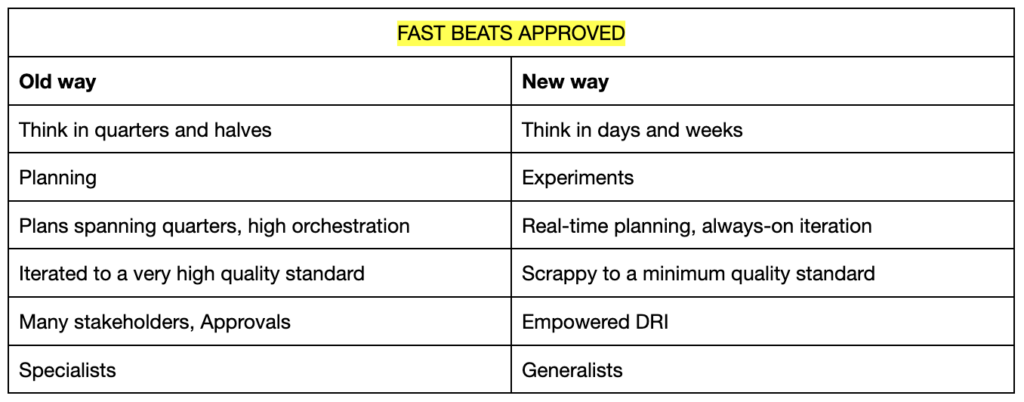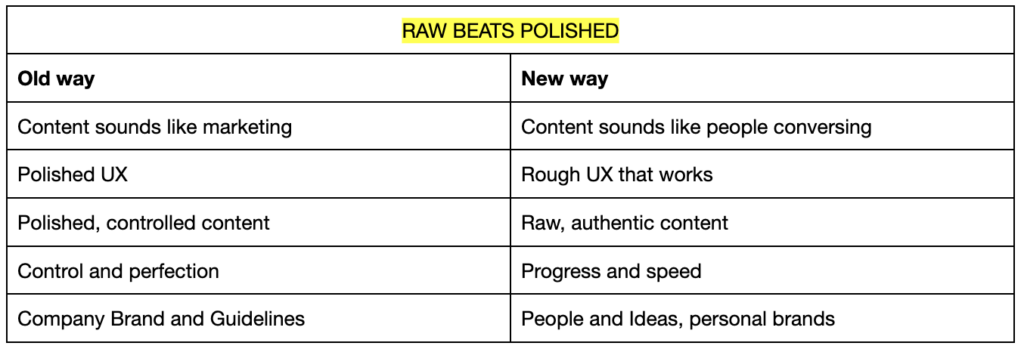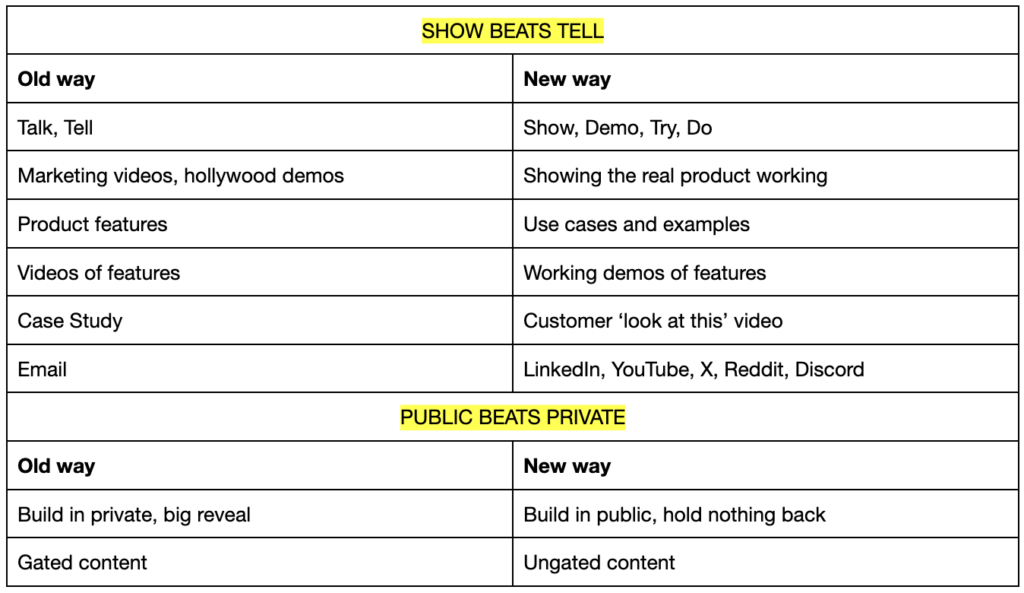Marketing in an AI World
There is a new way to do marketing, fit for the AI age.
The old way is too slow. It’s too inflexible. It’s too polished.
This is the new way:

Let’s get into it.
AI technology is developing so fast, all of us feel behind all the time. Marketing based on big planning, multi-org orchestration, singular themes that run for quarters, big launches that take months to plan, and big campaigns that don’t change, simply will not work. People are wasting precious time, energy, and money.
Early in big technology cycles, everyone copies everyone else’s positioning and messaging because the technology is so uncertain. Just look around, you can see it everywhere. To stand out, you can’t stand still.
This huge change isn’t surprising because it happens every time we’ve a new disruptive technology wave. During these times, entire ways of doing business first stop working, and then become obsolete. This is very predictable, going back many technology waves. We’re there with marketing: what used to work, no longer works.
As always with these new waves, some people will win big by being early, whilst others will get left behind.
The new way is very fast. Planning in the moment, week by week, evolving all the time as the market and competitive landscape change around you. It’s raw, authentic, unpolished, scrappy. It’s also technical, scientific, credible – because with AI, people need to understand what is real.
The new way has five parts:
1 Adaptable beats Consistent
Best practice is to have a clear brand, with clear positioning and messaging, and run consistent campaigns. Everyone following the same, set-in-stone content guidelines. But that is simply too inflexible, and you’re guaranteed to be out of date within a small number of months.

At Intercom, we no longer have a marketing calendar. We’re working month to month, setting ambitious goals at the start of each month, then setting weekly goals for each, and checking in on progress every week.
We have a rough idea of the big things coming in the next ~quarter, for example the next big Fin product launch, but that is it.
2 Fast beats Approved
What matters is being in the market, learning hard. Fast gets good quicker than good gets fast.
Co-ordination, orchestration, approvals. Slow, slow, slow.
Move to DRIs and empower them to ship experiments all the time. The DRI holds the quality standard, that’s very important. You must never ship crap.

At Intercom, we no longer have marketing teams/departments. We work in small cross-functional workstreams of
~5 people. Each workstream has a single DRI, and a clear goal.
Specialists are now learning new skills, using AI tools, and moving to become more generalist, broadening what they can do.
3 Raw beats Polished
Polished is slow. Raw is fast. But there is more to it. In the AI age, we increasingly wonder what is real. We look for signals that tell us something is genuine, authentic, real. These signals increase credibility.
Real content will win. Real people. Really talking.
Real people are rough around the edges, so show reality. The more you polish, the more you lose credibility.
‘Marketers who wanna market’ will lose. People don’t want wordplay, things jazzed up. People want honesty and content that sounds like how people really talk.
Shipping raw content at speed doesn’t mean ship AI slop. Stick to the fundamentals that have grounded excellent marketing for 100 years. Technology changes fast, but people change slowly. Ground your work in the science of human psychology, how we make decisions, and how we are influenced.

At Intercom we’re moving to a world where things are very clearly real.
We did our last product launch in person, live. We had Fin Labs, where you could use the real product, with your own customer data.
We sent our Product and Engineering team to CCW, the biggest tradeshow for Customer Service, to explain to people how the product works, and how we built it. No level of training can substitute a marketer or salesperson for the real people who built the product.
4 Show beats Tell, and Public beats Private
It’s very hard to know if an AI product is good. Some AI products can look really good, especially in a Hollywood demo, but in reality, in the wild, they don’t work properly.
So show your product. Really working. Show what it can do. Real demos, of real use cases, with real data.
If you can’t show your product really working with real data, get back to building.
Then build in public. Show people what you’re working on. Share what you’re learning. Show them what has been hard, what you’re trying to make things better.

At Intercom, we’re building in public. For months now, we’ve shared all our work in progress every single week.
We are building demos and demo environments for people to try Fin.
We’re investing heavily in customer evidence, and we now have a lot of it.
5 Technical beats Simplified
As with the beginning of all new technology waves, this is a very technical time. A time when the people who understand the technology win. This might sound obvious, but people don’t internalise it properly. You can’t market something you don’t understand.
The winners will be the best at explaining AI, not by reducing its complexity and technical nature, but by educating people on it.
To be successful, Marketers must understand how AI works: LLMs, Training, Prompting, Fine-tuning, Context windows, RAG, Embeddings, etc. And they must understand what AI can do, by using and trying AI tools, all the time, every day.
This change is going to put a lot of pressure on people in traditional marketing roles because understanding a consumer app, or a Saas app, was easy. AI is not easy. For example, product marketers and content marketers excel in taking what a product team has built, and turning it into excellent commercially focused messaging. Now, a lot of that skillset can be produced by a Marketing trained LLM, where it understands everything you give it: your marketing principles, brand voice, the entire human history of excellent marketing, etc.
So, the benefit you get from an excellent marketer must now be greater than a product team using that LLM, which means the marketer must deeply understand the technology, in order to have intuition for how to apply their experience and skills.

At Intercom, we’re hitting fast forward on marketers using AI tools, and we’re bringing in Product and Engineering people directly into marketing work to help everyone learn.
A final thought…
There are many new AI tools for marketing. There is a new marketing technology stack being built around AI. Investing time to try it, learn it, pioneer it, is imperative.
But do so in a way that is fit for this age. Embrace the new way far beyond the new tools available.
A mindset change is required, and fortitude is required. Changing your approach to marketing is risky, but I believe it is necessary to succeed in the AI age. At Intercom, we’re early with these changes, and much will change, but we’re already seeing the benefits.